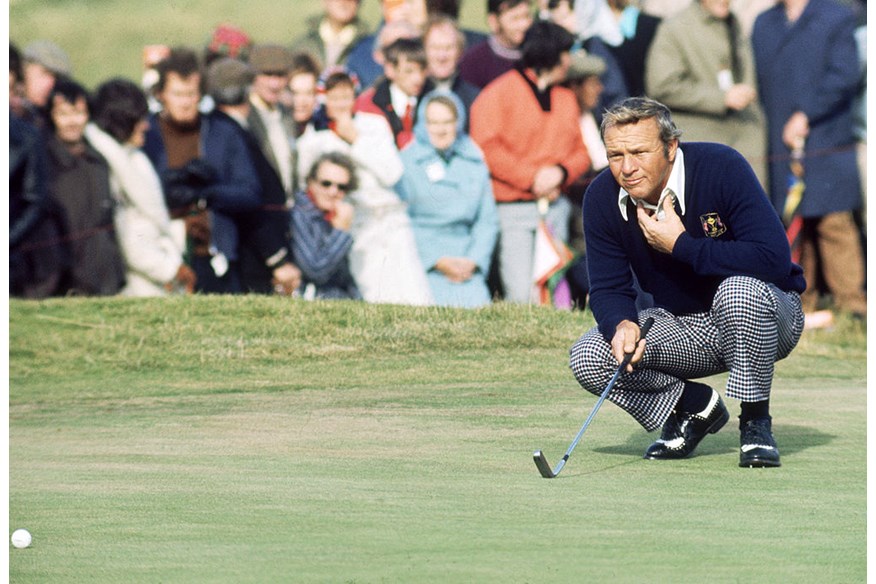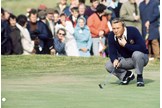Arnold Palmer 1929-2016
Last updated:
Arnold Palmer spent a lifetime in the game of golf.
During that time, he learned a few things – about life, about competing and about people and alsogave plenty back including his contribution towards the Arnold Palmer Hospital for Children.
We gleaned a little about his outlook on life, and his biggest influences, when we spoke to him last year over an Arnold Palmer ( a glass of iced tea and lemonade) the American’s drink of choice.
ARNOLD PALMER 1929-2016
A look at Arnold Palmer’s illustrious career
Nicklaus: Arnie was the king of our sport
Arnold Palmer’s greatest quotes
When I was a little boy my father took me to the golf course at Latrobe Country Club where he was head professional and greenkeeper.
I spent my time with him and the crew learning all about the game and what golf was all about. That had a lot to do with my attitude towards the game and that enjoyment lasted until I left to go away to college.
When I arrived at Wake Forest, I made a lot of good friends who were also very good golfers.
We played a lot of golf against each other and associated on and off the golf course. The competition of playing against the best young golfers in the college ranks prepared me well for my professional career.
I never really made any swing changes in my career. I started with a pattern when I began playing the Tour, and I stuck with it until today.
My father was my swing coach, and I saw him at least once a year for about 70 years, and he never changed anything.
He watched me for five minutes and went home. It’s like he put my grip on the club and my hands on the golf club when I was six years old and he said: “Boy, don’t you ever change it.” Well, I haven’t changed it.
So when I go out in the Pro-Am at my tournament at Bay Hill, I always just hope I can hit it in the fairway. But I hit it so far these days that I hear it land.
I was somewhat of an outgoing player. I loved the challenges of playing golf and enjoyed taking risks to make a shot or to win a match. I did that quite a lot, yes. I did lose some tournaments, but I also won a lot of tournaments with that attitude.
There are more physical specimens on Tour today than there was overall when I started. Though I’d like to think a lot of the guys were very physical, even when I played. But a lot of the guys just played golf.
They were golf professionals and they didn’t concentrate on physical fitness like the guys playing today. And of course, we have made that all possible for them with the trailers and the physical fitness that accompanies the Tour.
It’s a natural thing for them to be more physical. And I think it’s a great thing.
Early on, my father started talking to me about doing things in the game of golf. One of the things he always wanted me to do was go overseas and play, particularly in the Open Championship.
He always felt that you can’t be an accomplished golfer if you don’t win internationally and that became embedded in my mind. The good news is, I had the opportunity to do it, and do it with reasonable success.
Going to Britain and playing in the Open Championship was one of the greatest things in my life. The warmth and friendship of the British fans was overwhelming and it is still one of my favourite things to talk about and to remember from my golfing days.
I certainly enjoyed winning Majors and in fact just playing in them. My first win at the Masters in 1958 was one of the most thrilling victories of my career. I won again in 1960 and then went to the Open Championship at St Andrews for the first time. To win at Birkdale the following year was a real milestone in my career and to follow up the next year with a win at Troon was even better.
I’ve enjoyed a lot of great golf courses round the world. I could start by naming where I won some Majors like Birkdale, Troon and Augusta. Although I never won a tournament at Oakmont, I thoroughly enjoyed playing there.
I would be remiss if I didn’t mention my two home courses, Bay Hill in Orlando, Florida, and Latrobe Country Club in Pennsylvania, where I have played more rounds than at any other golf courses.
In my design work, I like to preserve as much of the natural surroundings on the golf course as possible.
I try to protect the environment and what it stands for in world golf. I can’t say that I try to replicate any of the courses that I’ve played, though. My philosophy is to follow what nature has given us and I try very hard to do that in all my designs.
People talk about stopping equipment technology, but I don’t think you can stop progress and I’m certainly in favour of that.
But I also have a great love for the older, dignified golf courses that I’ve had the opportunity to play and I would like to think that we will protect the integrity of these designs for years to come. I believe the golf ball is the single largest factor.
We need to keep an eye on that part of the game so it doesn’t get out of hand.
As a result of the charitable impact of my tournament, the Winnie Palmer Hospital for Women and Babies bore about 13,000 youngsters in 2010.
That was a record. We have opened up a new kidney function in the hospital and we are also working on a children’s cardiac centre. Overall, we are extremely pleased and proud of our hospital and our Medical Centre.

